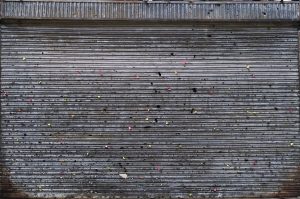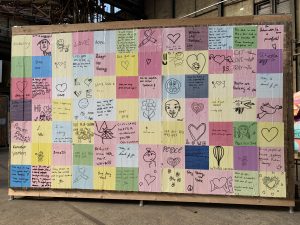This essay was written by Rex P. Nielson, BYU Humanities Center Director, as an extension of the Statement from the Director, which can be read here.
This past summer, I found myself thinking about transformation and healing while visiting a large street art installation in Amsterdam at the newly opened Straat Museum. There, I came across the work of the Lebanese street artist Jad El Khoury. Amid large-scale murals pulsating with color and motion, El Khoury’s piece Care Portal initially shocked me. Nondescript in color and size, especially when compared to the works that surrounded it, Care Portal is an oversized retractable shutter, the kind that can be found in nearly any urban setting. Typically, shutters like these are used by store owners to close up shop and protect property, and they rarely call attention to themselves. In the case of Care Portal, however, the large shutter, which measures 3.5 x 5 meters, is perforated by countless holes caused by shrapnel from explosions and bullets. As I viewed it, I could not help but think of the violence symbolized by those holes, which evoke not only the memory of devastating political conflict, but also the ongoing trauma and terrifying realities experienced by all who live in war zones.

What does resilience mean for those who have experienced the trauma of war? What might it mean for the survivors of violence to “return to equilibrium”? What does recovery mean in a situation like this? What does healing look like?
Standing before El Khoury’s work and upon closer examination, however, I realized that the holes in this shutter were nearly all filled with small, rolled slips of paper. What I had not noticed at first was a small table to the side of the work with an invitation from the artist to compose a message of hope to those who live in war zones worldwide. In response, hundreds of people had written messages, rolled them into the shape of a tiny scroll, and fitted them into the holes in the shutter. For me, the gesture evoked the Western Wall in Jerusalem, with its many thousands of prayer notes. In this case, however, the shutter’s position allows viewers to walk all around it. On the backside of the shutter, the artist offers a sample of the messages left by visitors in multiple languages: “Today I dreamt of you,” “Don’t give up,” “Your courage inspires us,” “Peace,” “Breathe,” “Don’t lose hope.” In many cases, the message was simply a quickly drawn line image, a wordless but moving response to tragedy.

Holes filled with hope. The work struck me for its response to violence and its suggestion that communal participation is necessary for healing. In effect, El Khoury’s creative intervention invites all viewers to participate in the shared work of resilience by transforming the material memory of war into a restorative message of solidarity, love, and peace.
In addition to the skilled insight of mental health professionals and scholars from multidisciplinary fields, El Khoury’s powerful installation reminds me that the creative and critical work of the humanities likewise contributes to promoting resilience in our society today. The Humanities, like Care Portal, inspire us to engage creatively with the world. They foster compassion and empathy, and they teach us to reframe, contextualize, identify patterns, think flexibly, and adapt—all while helping us to understand and respond to complex realities. And like Care Portal, the Humanities also help us to transform and to heal. In a world conditioned by vulnerability and subject to adversity and stress, let’s not forget the role that creativity plays in developing our individual and collective resilience.
Image Credits: Jad El Khoury






